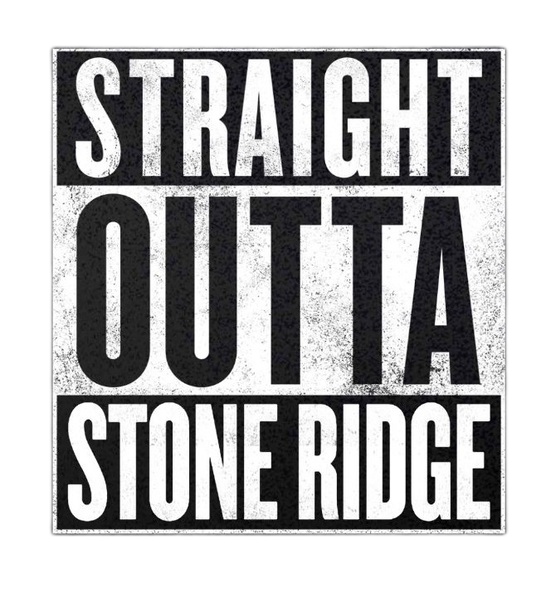 How I Spent My Summer Vacation
How I Spent My Summer Vacation
Starting in late May, along with my wife Anna and stepson Jacky, I moved from Staten Island, where I have lived since 1967, to Stone Ridge, a hamlet within Marbletown, NY, a 30-minute drive away from Kingston, Woodstock, New Paltz, and Poughkeepsie. Hence the absence of new posts here at the blog since mid-June. (And thanks to those subscribers and other readers who emailed me to inquire about that.)
Once we decided to make the move, planned since 2018 (when we purchased the upstate property), we managed to complete it by mid-July, leaving enough time to get the Van Duzer Street house ready to catch the summer/fall market. You can take a virtual tour of it here.
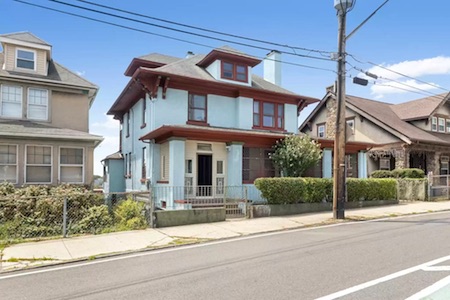
465 Van Duzer St, Staten Island, NY 10304
•
Purchased in fall 1969, that domicile served as home base for my private life as well as all but the first two years of my professional life to date. A local architect, James McDermott, designed and built it in 1910 for himself and his family. Constructed from top to bottom like the proverbial brick shithouse, of stucco-covered hollow-core blocks (called “stucco on tile” back in the day), it has two full stories plus a full finished attic and finished basement. So it provided ample room for family activity plus space for my office and extensive library. We even had a small back garden where we grew excellent tomatoes, figs, and other vegetables and fruits.
Inevitably, we had to leave some things behind — including our late cat Billie the Bengal, who rests (we hope forever) beneath the fig tree. Mini, our mixed-bred feral kitten who has reached her tenth year in relatively good health, accompanied us and has since made herself comfortable in her new surroundings.
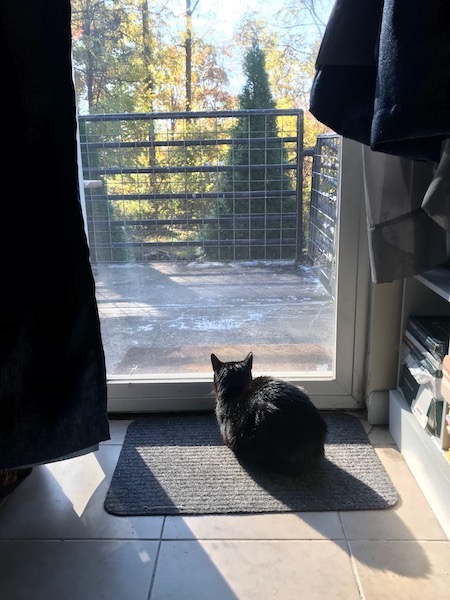
Mini watching birds, Stone Ridge, NY, 10-22-22
•
The New York Times discovers this neighborhood periodically; see “Stapleton, Staten Island: Revitalizing Old Homes and Tired Blocks,” from 2016. So do other local media outlets, such as NY1, which recently ran this feature on Stapleton. Yet, for a combination of reasons (political, economic, cultural), Stapleton itself, and the whole North Shore of Staten Island, remained peculiarly static for the entire half-century I lived there. Aside from some development right around the ferry terminal, nothing really changed there over all those years.
At the time I moved over from Manhattan in 1967 I believed the North Shore had the potential of turning into a bohemian/creative professional haven. In fact, I said as much in the first feature article about Staten Island ever published by New York magazine. And there have been and are, indeed, authentic bohos (not faux-bohos), serious visual artists and musicians and writers and other creative pros living there. But it never jelled as a thriving community thereof, and most of the people I got to know there have either left or passed on. As a result of which there’s nothing much for me to miss. Pulling up those roots has proved painless, and I already look forward, not back.
•
Just 90 miles due north of Manhattan, but much quieter and small-town/rural, Stone Ridge/Marbletown has proved definitely less abrasive than the outer-borough/suburban environment of Stapleton. Here’s a link to a recent New York Times feature on Stone Ridge that, with its accompanying slideshow, gives some sense of the place.

Our house in Stone Ridge (1)
The new house, seen above and below, surrounded by trees on a private lane, has an intriguing backstory that I’ll detail in a future post. We share the outside spaces with birds of various species, including red-tailed hawks (who we just saw heading south for the winter), squirrels and chipmunks, moles and voles, field mice, fruit bats, a small herd of deer, a groundhog, and a black bear who occasionally strolls down the lane toward the neighboring orchard but has (so far) left our trash bins alone.
A perfect setting for pursuing my current front-burner project, the various permutations of the Capa D-Day investigation, while organizing my papers and other professional materials into a coherent archive for eventual deposit with an appropriate institution.
I will provide progress reports as this relocation moves along, as well as some commentary on our new physical and cultural environment. Right now the leaves are changing colors, and as they fall we bag them for mulching the vegetable garden next spring. It’s gotten cold enough at night that we have the boiler on. We have begun to prep the place for winter. Settling in.
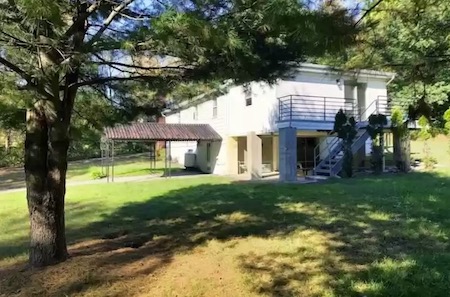
Our house in Stone Ridge (2)
•
For reasons too complicated to go into here, we find ourselves for the moment without a car in a situation where almost everyone has wheels. So far, this has not proved a major impediment. Within easy walking distance we have access to an excellent supermarket, drugstore, and liquor store in a mini-mall; a post office just a bit further on; and, not far beyond that, a hardware store and the perfect small-town library, the latter complete with silver-haired female librarians who can help one find anything in their holdings, navigate their online catalog and options, and operate their combination scanner/printer.
It even has an attached book store — a small, unheated pre-fab shed open 3-5 p.m. on weekdays, big enough to hold about a thousand books, CDs, and DVDs, all priced at $2 each. A little like the bargain racks outside Strand Books, one of my old haunts. Just enough of a secondhand bookstore that, when I feel the urge to browse in one, I need look no further.
•
We took out a family membership in the library, of course. As my first choice, I borrowed cultural historian Sean Wilentz’s 2010 tome Bob Dylan in America. Wilentz, son of Eli, the owner of the 8th Street Bookshop in Greenwich Village (which I haunted in my teens), has served for years as the “historian-in-residence” for Dylan’s official website, expectingrain.com, and has written about Dylan at some length, so I came to this with high expectations. Alas, I found it disappointing. Though well-researched, it lacks what I call a “therefore” — it presents as an argument on behalf of a premise that never really gets articulated clearly, much less effectively proven.
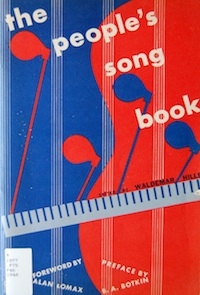
“The People’s Song Book” (1948), cover
Instead, it meanders, starting with its opening chapter on the composer Aaron Copland and his connection to the American folk-music tradition as promulgated by the Popular Front during the Thirties and Forties. Wilentz works hard to convince the reader that Copland’s combination of leftish tendencies and musical experimentation with vernacular forms constitutes a resonant parallel to Dylan’s. Yet, curiously, The People’s Song Book — the 1948 paperback mélange of classic folk songs and twentieth-century labor-left anthems — goes completely unmentioned here. A commonplace in left-wing NYC households of that period, this compilation served as the printed bible of the nascent folk revival of the late Fifties and early Sixties. Dylan would surely have encountered it once he hit the Big Apple, likely even in Minneapolis’s Dinkytown before that as he first engaged with the folk-music scene. (As a red-diaper baby myself, I grew up with those songs and that book, as I’ve discussed here previously.)
Wilentz’s book moves chronologically but not systematically through Dylan’s career, focusing on selected moments, including several Dylan concerts that he attended over the years. In one chapter he traverses the making of Dylan’s 1965-66 album Blonde on Blonde, giving an excellent track-by-track sketch, yet fails to indicate the source of that astonishing double album’s title — a celebrated if apocryphal description of film actress Jean Harlow, who died at the age of 26, another connection between Dylan and film, of which Wilentz otherwise makes much. He recounts his experiences at a November “Rolling Thunder” concert, describing that tour in detail — yet neglects to mention that bassist Rob Stoner, who led the accompanying band, is the son of Farm Security Administration photographer Arthur Rothstein, whose Depression-era Dust Bowl images influenced John Steinbeck’s The Grapes of Wrath, a book Dylan surely knew by an author whom, according to Wilentz, he revered.
He offers a deep dive into several songs, including Dylan’s own “Blind Willie McTell” and one he likely learned from McTell, “Delia” — yet fails to note that the real-life story on which the latter was based, an 1899 murder of one African American teenager by another, took place in the Yamacraw district of Savannah, Georgia — later made famous as the inspiration for stride pianist James P. Johnson’s 1927 “Yamekraw (A Negro Rhapsody),” for jazz piano and orchestra.
In short, a number of missed connections. Yet, more important by far, the connections Wilentz does make don’t reverberate, at least for me. The result feels workmanlike and earnest, but not engaging. And it doesn’t help that the concluding “Coda” addresses Dylan’s 2009 Christmas in the Heart, at the time his most recent release — an album that, whatever its virtues, does not number high on anyone’s list of major Dylan works.
For me, the best part of the book is its front-cover photo, by W. Eugene Smith. I’ve seen a lot of Dylan photos over the decades, including a bunch of memorable ones. But this one is new to me. Characteristic of Smith, it’s a minor-key image, made in Columbia’s Manhattan studio during a recording session. Dylan, seen from mid-thigh up, wears a dark jacket and shirt and pants, his harmonica in its holder around his neck, a Fender guitar strapped on and plugged in, held exactly horizontally, ready to go. A microphone hangs, almost invisibly, suspended just above and to his left. So he’s already gone — or is in the very process of going — electric.
Dylan knew Smith and so probably knew his work, had attended and performed in the already legendary jam sessions at Smith’s 6th Avenue flower-district loft, so he doesn’t ignore him or turn away. He’s smoking a cigarette, presumably between takes, and a curl of smoke wafts toward his nostrils; the cigarette and that wisp of smoke form the image’s central highlight, drawing your attention to Dylan’s face, half-hidden by his hand, so you don’t see his mouth. He’s wearing shades, yet a hint of the eyes behind them comes through, enough to indicate that they’re not closed, and he’s neither looking up at the ceiling nor down at the floor. No, he’s staring directly into the camera — straight at Smith as he makes this exposure, straight through Smith’s camera at you, simultaneously guarded and confrontational. And he looks, at this moment, in this image, fucking dangerous.
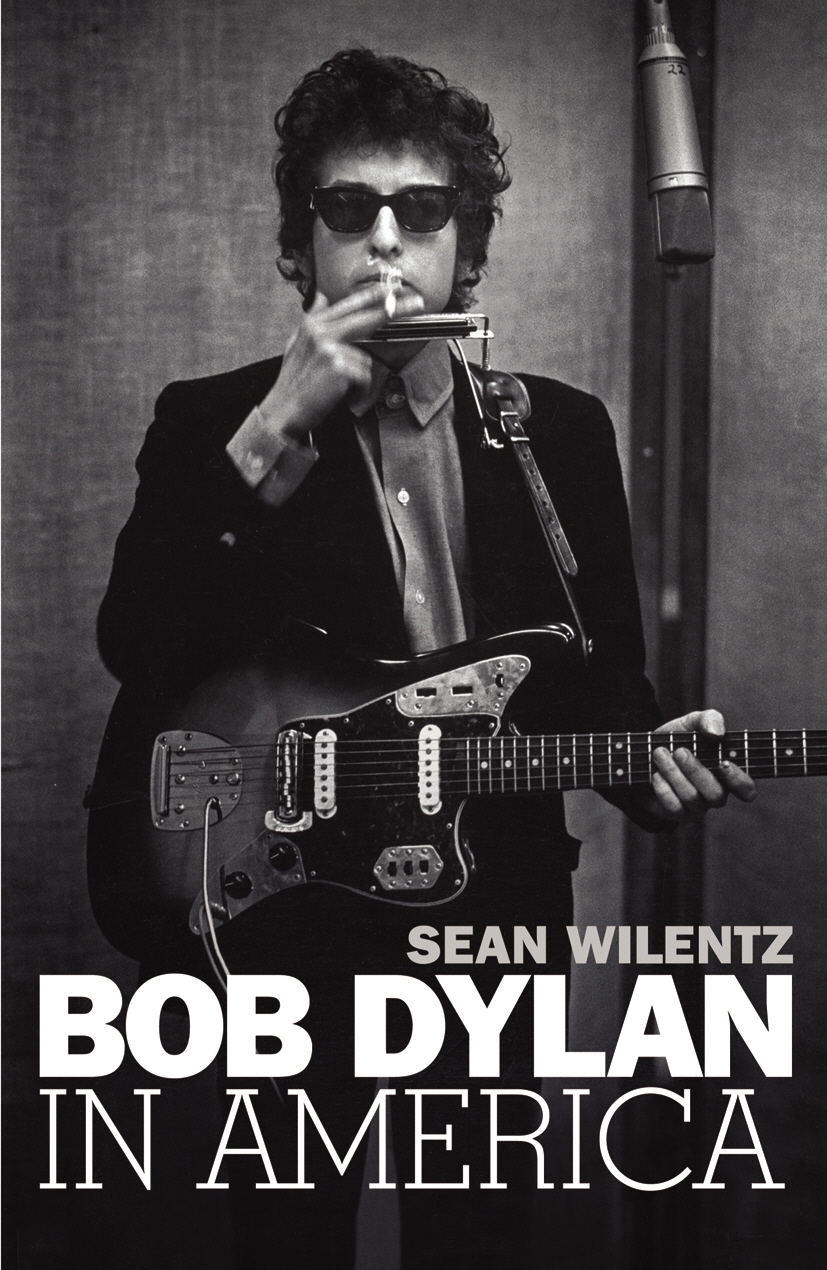
W. Eugene Smith, Bob Dylan, 1965 (Sean Wilentz cover, 2009)
•
Getting Back on the Horse
This blog post represents my first actual writing effort since last May, a hiatus of almost four months — certainly one of the longer breaks I’ve ever taken from practicing my craft, possibly the longest hiatus ever.
However, during that stretch I made notes toward a number of new posts (including this one), and prepared a number of Guest Posts for publication here. We hereby resume our (relatively) regular posting schedule, so you can look forward to a varied menu of offerings for the fall and winter. In addition to newly written posts I will, as usual, dip into the archives for relevant and interesting past writings. I also have several Guest Posts in the editorial pipeline.
Vote!
After the move I made sure to update my voter registration. This week I received, filled in, and returned my absentee ballot, the first I’ve filed from this new address. Whether you do so in person or via mail, I urge you to vote in this midterm election as if democracy depends on it. Which it does.
The sticker below, designed by 14-year-old Hudson Rowan, won the “2nd Annual Ulster Votes I Voted Sticker Contest” for 2022 and then went viral. As a new resident of Ulster County, I proudly display it here, and tip my hat to this emerging outsider artist.

•
Special offer: If you want me to either continue pursuing a particular subject or give you a break and (for one post) write on a topic — my choice — other than the current main story, make a donation of $50 via the PayPal widget below, indicating your preference in a note accompanying your donation. I’ll credit you as that new post’s sponsor, and link to a website of your choosing.
And, as a bonus, I’ll send you a signed copy of my new book, poetic license / poetic justice — published under my full name, Allan Douglass Coleman, which I use for my creative writing.






So glad to see you return. About the time I was trying to find reading opportunities you “disappeared.” I wanted a source for a discussion of “purpose-based” photography beyond the fine art pursuit I’ve been in for years and I thought you’d be dead honest about how much effect a lone photographer can have on something like conservation, carrying the principles of present ing images into revelations of the natural world. In any case, congratulations on the new house you’re creating a home in, ever onward!
Thanks for the good words.
W. Eugene Smith described photography as “a still, small voice at best.” And it’s not easy to even ascertain, much less quantify, the actual impact that a given photograph or even a body of photographic work has on something like a situation involving conservation.
Yet even if they only preach to the choir by heartening those involved in the conservation movement, images of conservation efforts and of what people seek to conserve make a difference. And provide a record of those situations on which people in the future can reflect. Perhaps they also draw others to that cause, and provoke yet others to rethink their attitudes toward the issue.
You could ask the same question about a “lone writer” or a “lone voter” or a “lone teacher.” In all such cases I think the basic answer is that your “purpose-based” activity has to have its roots in the conviction that it’s the right thing to do, regardless of visible return on the investment of time and energy and commitment.
Best of luck to all of you as well as the spring garden!